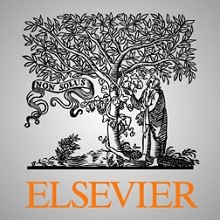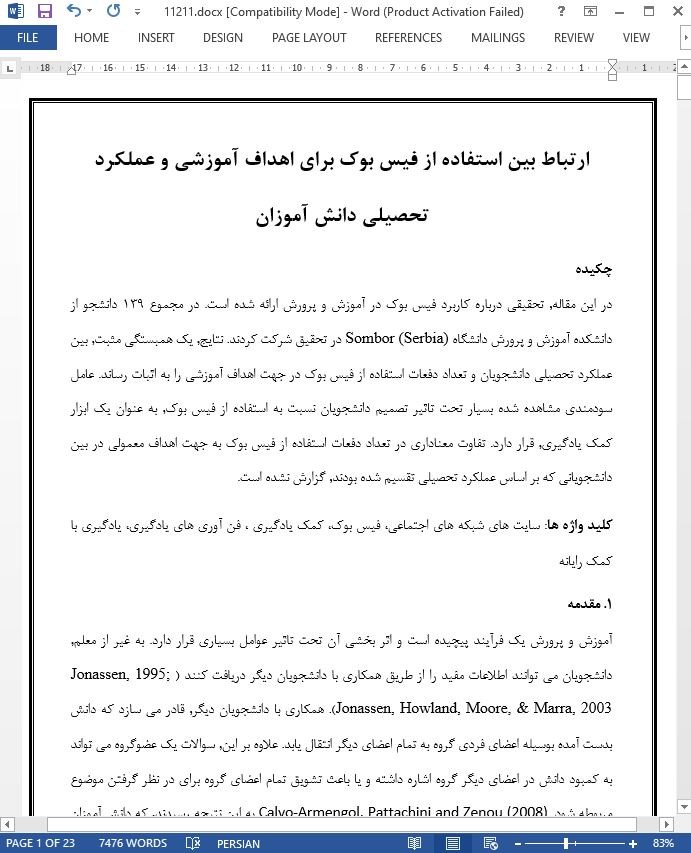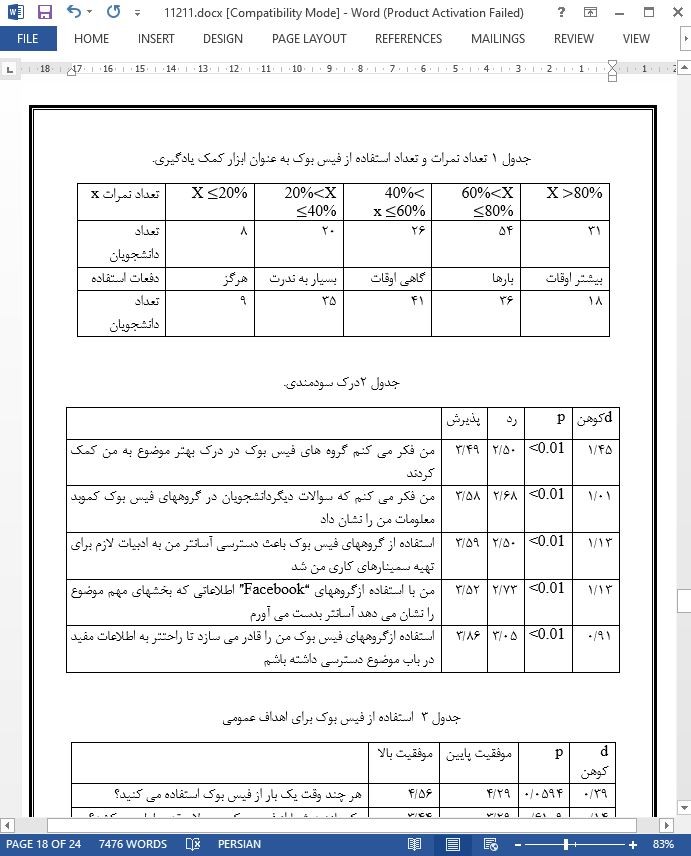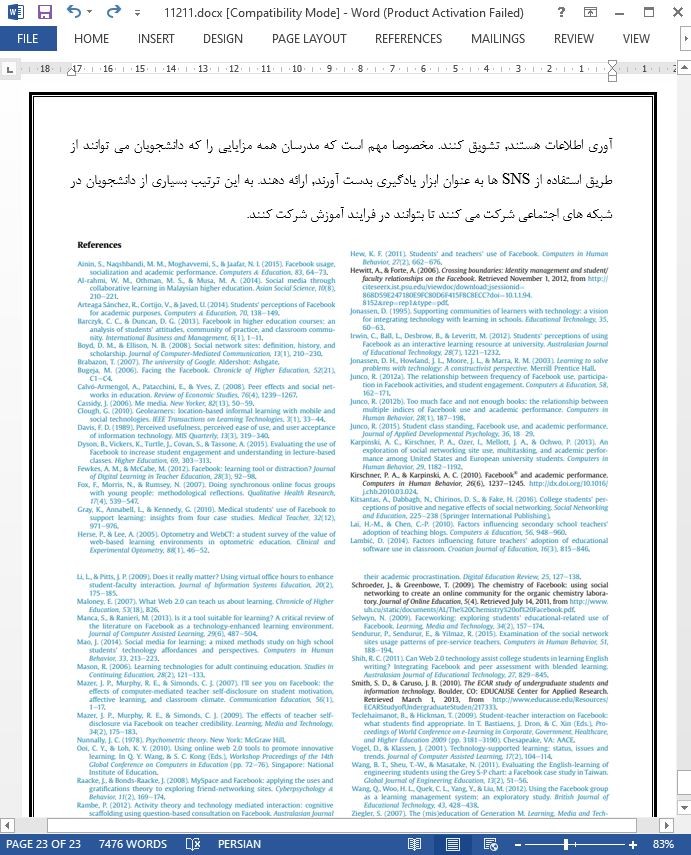
ارتباط بین استفاده از فیس بوک برای اهداف آموزشی و عملکرد تحصیلی دانش آموزان
چکیده
در این مقاله, تحقیقی درباره کاربرد فیس بوک در آموزش و پرورش ارائه شده است. در مجموع 139 دانشجو از دانشکده آموزش و پرورش دانشگاه Sombor (Serbia) در تحقیق شرکت کردند. نتایج, یک همبستگی مثبت, بین عملکرد تحصیلی دانشجویان و تعداد دفعات استفاده از فیس بوک در جهت اهداف آموزشی را به اثبات رساند. عامل سودمندی مشاهده شده بسیار تحت تاثیر تصمیم دانشجویان نسبت به استفاده از فیس بوک, به عنوان یک ابزار کمک یادگیری, قرار دارد. تفاوت معناداری در تعداد دفعات استفاده از فیس بوک به جهت اهداف معمولی در بین دانشجویانی که بر اساس عملکرد تحصیلی تقسیم شده بودند, گزارش نشده است.
1. مقدمه
آموزش و پرورش یک فرآیند پیچیده است و اثر بخشی آن تحت تاثیر عوامل بسیاری قرار دارد. به غیر از معلم, دانشجویان می توانند اطلاعات مفید را از طریق همکاری با دانشجویان دیگر دریافت کنند (Jonassen, 1995; Jonassen, Howland, Moore, & Marra, 2003). همکاری با دانشجویان دیگر, قادر می سازد که دانش بدست آمده بوسیله اعضای فردی گروه به تمام اعضای دیگر انتقال یابد. علاوه بر این, سوالات یک عضوگروه می تواند به کمبود دانش در اعضای دیگر گروه اشاره داشته و یا باعث تشویق تمام اعضای گروه برای در نظر گرفتن موضوع مربوطه شود. Calvo-Armengol, Pattachini and Zenou (2008) به این نتیجه رسیدند, که دانش آموزان تحت تاثیر شبکه های اجتماعی خودشان نتایج بهتری در مدرسه بدست می آورند.
7. نتیجه
تحقیق شرح داده شده در این مقاله اطلاعات جدیدی را درباره اثراتی که می توان با کاربرد فیس بوک به عنوان ابزار کمک یادگیری بدست آورد, فراهم می کند. تحقیق ثابت کرد که استفاده از فیس بوک در آموزش و پرورش اثرات مثبتی روی معلومت دانشجویان دارد. یک رابطه مثبتی بین تعداد دفعات استفاده از فیس بوک به عنوان ابزار یادگیری و تعداد نمرات واقعی بدست آمده توسط دانشجویان در طول دوره طراحی نرم افزار آموزشی و رسانه ای وجود دارد. تحقیق حاضر تنها یک SNS فیس بوک را دربر می گیرد. اما از تحقیق حاضر کم نمی شود. چون مرکز توجه روی ویژگی های تخصصی سایت نمی باشد. اما می توانست مزیتهایی از رابطه آسانتر بین روابط دانشجو با دانشجو و دانشجو با معلم را داشته باشد. برای اهداف آموزشی دانشجویان بطور نمونه از توضیحات, لینکها و چت ها, برای مثال کارکرد اصلی SNS ها, استفاده کردند. به همین دلیل نتایج بدست آمده برای SNS ها با ویژگی های تخصصی و اجتماعی مشابه که امروزه وجود دارد یا در آینده وجود خواهد داشت, قابل اجرا می باشد.
Abstract
In this paper a research on the application of Facebook in education is presented. A total of 139 students of the Faculty of Education in Sombor (Serbia) participated in the research. The results establish a positive correlation between the academic performance of students and the frequency of use of Facebook for educational purposes. The factor of perceived usefulness greatly affected the decision of students to use Facebook as a learning aid. No significant difference in the frequency of use of Facebook for general purposes has been reported between the groups of students divided by the academic performance.
1. Introduction
Education is a complex process, and its effectiveness is influenced by many factors. Except from the teacher, students can also acquire useful information through cooperation with other students (Jonassen, 1995; Jonassen, Howland, Moore, & Marra, 2003). Cooperation with other students enables the transfer of knowledge acquired by individual members of the group to all other members. Furthermore, questions of a group member can point out the deficiencies in the knowledge of other members, or encourage the entire group to consider a certain relevant topic. Calvo-Armengol, Pattachini and Zenou (2008) concluded that under the influence of their social networks, students achieved better results in school.
7. Conclusion
The research described in this paper provides new data about the effects that could be achieved by the application of Facebook as a learning aid. It has been proven that the use of Facebook in education has positive effects on the knowledge of students. There is a positive correlation between the frequency of use of Facebook groups as a learning aid and actual number of points attained by students during the course “Designing Educational Software and Media”. This research encompassed the use of only one SNSeFacebook, however it does not reduce the importance of this research, since the focus was not on the technical features of the site, but the advantages that could be attained by enabling easier communication in the student-student and student-teacher relations. For educational purposes, students typically used comments, links and chat, i.e. the basic functions of SNSs. For this reason, the acquired results are applicable to other SNSs with similar technical and social features, that exist today or will exist in the future.
چکیده
1. مقدمه
2. مرور ادبیات
2.1. استفاده SNSs در آموزش و پرورش
2.2. استفاده از فیس بوک در آموزش و پرورش
3. روش تحقیق
3.1. فیس بوک به عنوان یک ابزار کمک آموزشی
3.2. اهداف تحقیق و فرضیه
3.3. طرح تجربی
3.4. فرآیند
3.5. سنجش
3.6. تجزیه و تحلیل
4. نتایج
5. تبادل افکار
6. پیشنهاداتی برای تحقیقات آینده
7. نتیجه
Abstract
1. Introduction
2. Literature review
2.1. SNSs use in education
2.2. The use of Facebook in education
3. Research method
3.1. Facebook as a learning aid
3.2. Research objectives and hypotheses
3.3. Experimental design
3.4. Procedure
3.5. Measures
3.6. Analyses
4. Results
5. Discussion
6. Recommendations for future research
7. Conclusion
- اصل مقاله انگلیسی با فرمت ورد (word) با قابلیت ویرایش
- ترجمه فارسی مقاله با فرمت ورد (word) با قابلیت ویرایش، بدون آرم سایت ای ترجمه
- ترجمه فارسی مقاله با فرمت pdf، بدون آرم سایت ای ترجمه



